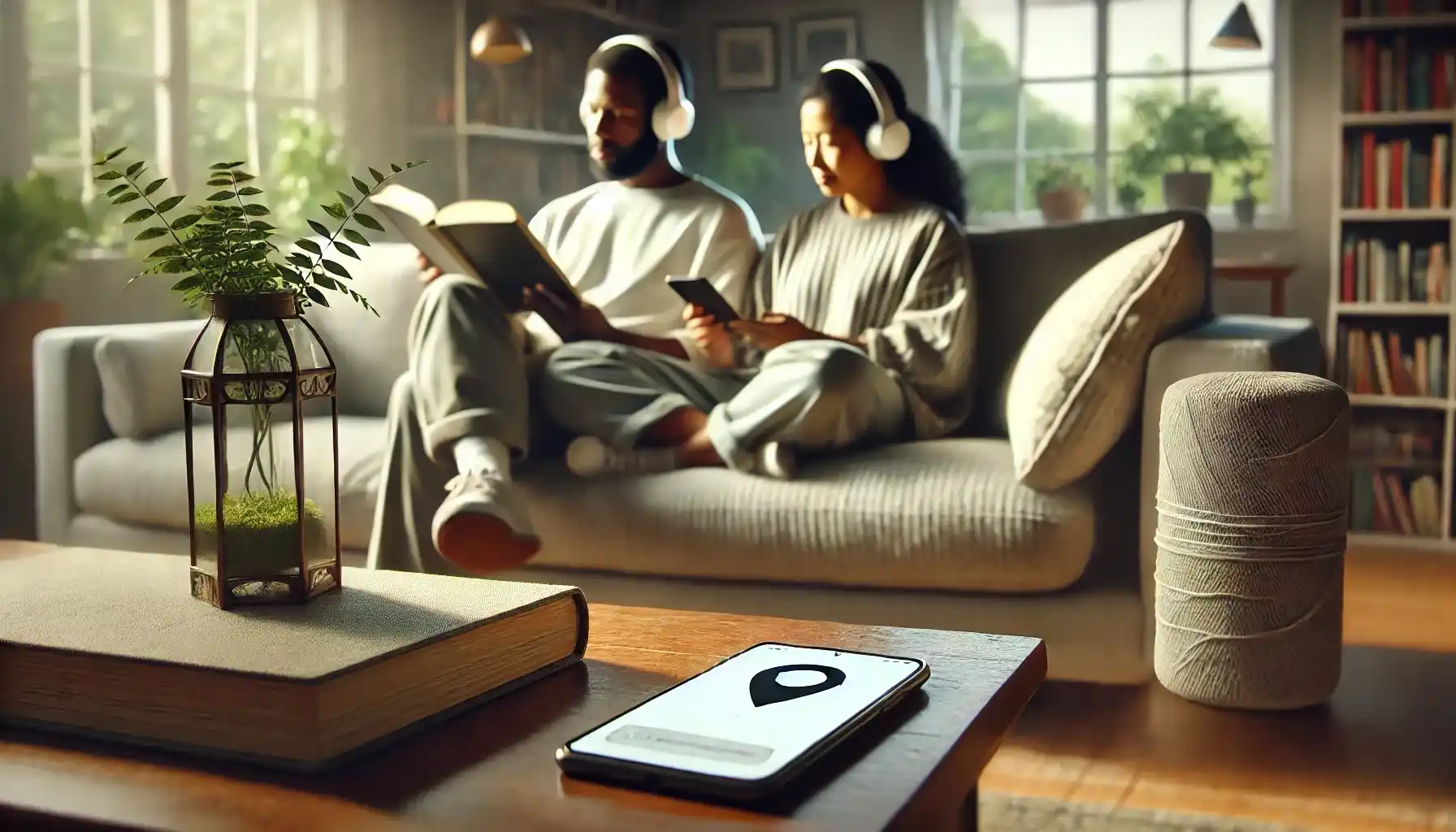
Mental Training for the Self: How to Stay You Without Disappearing in Others
Have you ever thought about how a phone tracker works: a quick glance at the screen, you see a geotag – a dot on the screen, and now you have peace of mind that your loved one is fine. Not because you’re in control, but because you’re connected. Emotional connections work similarly – it is important not to monitor, but to stay present without losing yourself.
In many relationships, we become that “tracker” ourselves – adjusting, second guessing, dissolving into someone else’s rhythm. It seems that to be a good partner or friend is to forget your boundaries, desires, and fatigue. But in reality, self-care is not selfishness, but a way to stay resilient and keep loving.
So, today we are going to speak about inner navigation. About mental training that will help you not to disappear into someone else’s needs, not to lose your focal point and learn to be present not out of anxiety, but out of choice. After all, you are not an app. You are a person. And you should have a dot on the map, too.
Why Inner Grounding Matters
Have you ever caught yourself changing your mood because someone else walked into the room stressed or distant? That is so called “emotional mirroring”, i.e. your nervous system adapting to someone else’s energy without you realizing it. It’s subtle, but over time it pulls your focus so far outward that your own desires, thoughts, and preferences get blurry and you become responsive, not reflective.
You should also know that disappearing into others rarely happens overnight. Usually, it starts with small self betrayals: saying “I’m fine” when I’m not, canceling your plans because “someone else might need you,” or putting your dreams on hold to “keep the peace.” Such self neglect may seem like kindness, but it is a slow withdrawal from your own emotional home.
Micro-Practice: Return to Your Center
One of the most effective ways to regain your inner footing is to do a simple daily check in: pause, breathe deeply, ask, “What am I feeling right now? What do I need?”
Combine this with a grounding breath: inhale for 4, hold for 4, exhale for 6. Do this three times. Itn has a subtle but powerful effect – like hitting the mental reset button.
Pro tip: Keep a 5-minute mood diary. According to the University of Rochester Medical Center, even short daily diary entries improve emotional regulation and help clarify inner needs. You do not need a fancy template – all you need is to simply hear yourself again.
In a world where empathy is often confused with self-sacrifice, the first mental muscle you need to exercise is presence without absorption. To take good care of others, you must first understand where you are on your own emotional map.
The Care Myth: When Support Turns into Self-Erasure
Usually, it starts with the best intentions: staying up late to help someone finish a project, shelving your needs because theirs seem more urgent, offering comfort before being asked. But over time, this becomes a pattern – not a choice, but an instinct. You begin to believe that being needed is the same as being loved.
Psychologists call this emotional enmeshment – a relationship dynamic where your emotions are tightly tied to someone else’s. You feel what they feel, you think about what they think, and eventually, you act on what they need, even when it costs you. It’s a quiet kind of burnout, where you are constantly pouring without being refilled.
Here’s a tool to change this dynamic: try the “Theirs vs. Mine” mapping exercise. Draw two circles. In one, list everything you have emotionally taken on in the last week. In the second, cross out the things that really don’t belong to you. You’ll be surprised to find out how much of the weight you’re holding was not meant for your shoulders.
According to the American Psychological Association (APA, 2022), people with clearly defined emotional boundaries experience 28% less chronic stress and report higher levels of resilience in close relationships.

The “No” Skill: Building Boundaries with Confidence
Thus, taking all the above saying “no” isn’t rejection. It is clarity. And when practiced kindly and consistently, it actually strengthens trust. So, start by creating three personal “go-to” responses you can use when a firm but respectful boundary is needed. Examples:
- “I care about this, but I can’t take it on right now.”
- “Let me get back to you after checking in with myself.”
- “That doesn’t work for me, but I hope you find what you need.”
Like any muscle, the “no” skill gets stronger with use. Try it in low-stakes situations first: declining extra responsibilities, honoring your need for rest, asking for space. Protecting your energy is not selfish – it is strategic, how you preserve the best parts of you, so you can show up fully when it truly matters.
Connection Without Control — And a Place Called “Me”
Being present in someone’s life doesn’t require you to hover. In fact, one of the healthiest forms of intimacy is rooted in freedom – the space to breathe while still feeling held.
But let’s be honest: in the digital age, it is tempting to stay overly connected. We check if they’ve read the message. We wonder why they’re “online” but not replying. We spiral. And often, it’s not about them – it’s about our own discomfort with uncertainty.
True presence doesn’t come from knowing everything – it comes from trusting enough not to.
It doesn’t mean that you give up your desire for intimacy but just means you have intentions about how you express that closeness. Maybe it’s sending a thoughtful voicemail message instead of calling five times. Or maybe it’s shared digital routines – a synchronized calendar for appointments, mutual reminders for down time, or dedicated “me time” when you both disconnect. And sometimes, tools can help – without overstepping.
Take the example of Number Tracker. You don’t need to control everything to be present. You can know your loved one’s location without calling constantly or worrying in silence. The app works like a digital thread: soft, unobtrusive, and reassuring. It allows you to:
- Set gentle “safe places” like home, gym, or school
- Receive alerts if someone moves beyond them
- Share real-time routes during travel or long commutes
- Rely on its AI assistant to recognize patterns and suggest helpful insights
And remember, your actions within the app are about support, not control (a quiet layer of care that respects autonomy).

To Ground Yourself So You Don’t Disappear
Being close doesn’t mean getting lost. Sensitivity doesn’t equal dissolution. You’re not a GPS, a backdrop for someone else’s life, a constant “yes” to everything. Real intimacy begins where you remain yourself – with boundaries, with breathing, with a dot on your internal map. Stay connected, but don’t lose the signal with yourself.
You may also like
Latest Articles
- Modern Rarities: Premium-Appraised Quarters Released in 2020s

- Old Age Is a Joy Nowadays: Free Games That Will Help to Boost Your Memory

- The Historical Significance of Coins Depicting Sports

- Mental Training for the Self: How to Stay You Without Disappearing in Others

- Why Strength and Conditioning Are Vital for Athletes

Calendar
| M | T | W | T | F | S | S |
|---|---|---|---|---|---|---|
| 1 | 2 | 3 | 4 | 5 | 6 | 7 |
| 8 | 9 | 10 | 11 | 12 | 13 | 14 |
| 15 | 16 | 17 | 18 | 19 | 20 | 21 |
| 22 | 23 | 24 | 25 | 26 | 27 | 28 |
| 29 | 30 | 31 | ||||
